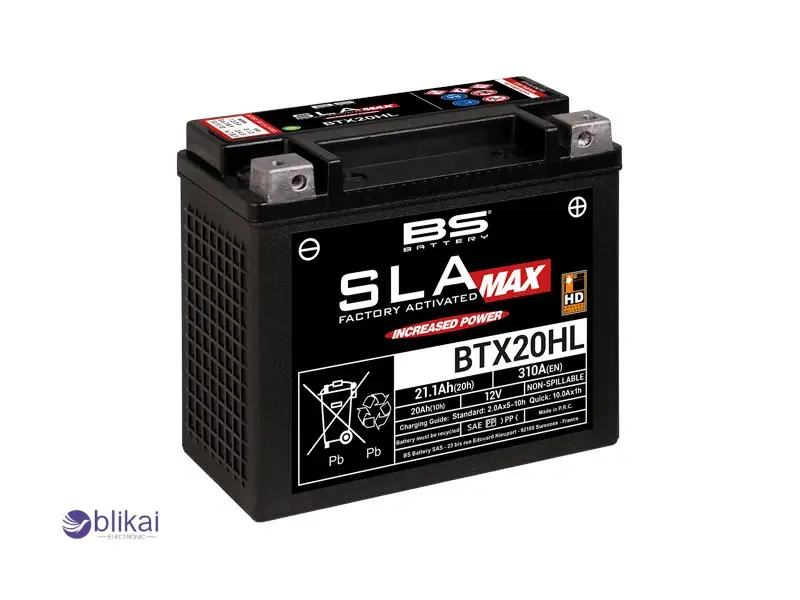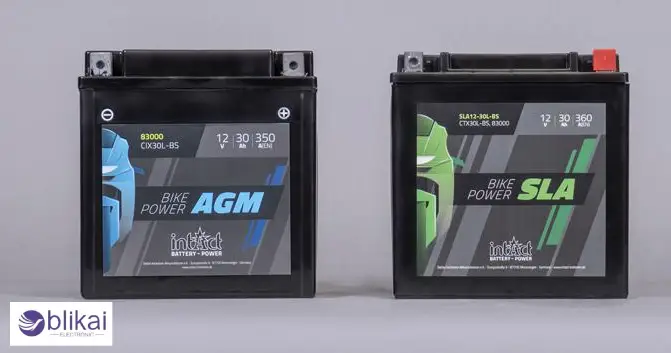SLA Battery: Guide to Sealed Lead-Acid
What is an SLA Battery?
A SLA battery is a rechargeable battery that has become very popular in industrial and consumer use. They are closed, that is, the electrolyte is fixed in place, in the form of a gel, or it is held in a fiberglass mat, so spillage is eliminated and corrosion chances are minimized. The batteries find applications in the backup power system, emergency lighting, uninterrupted power supply (UPS), medical equipment, and small electric cars because they are reliable and maintain a constant power supply.
Basic Structure and Components
The structure of an SLA battery is deceptively simple yet highly effective. It mainly contains lead plates, a chemical electrolyte, separators and a robust outer casing. The fundamental locations of the electrochemical reaction are the lead plates, which are usually covered with lead dioxide and the spongy lead (positive plate and negative plate, respectively). The electrolyte is in either a fiberglass mat (AGM) or gelled, which enables the battery itself to be sealed and maintenance-free. Separators block short between the plates and permit the passage of ions. The outer casing is normally composed of a strong plastic material that is impact and chemical-corrosion-resistant. The design guarantees the durability, safety and reliable energy storage even in hard environments.
Difference Between SLA and Traditional Lead-Acid Batteries
The most significant variance is maintenance requirements. Flooded batteries have to be topped with distilled water to be able to sustain the level of electrolyte, but SLA batteries are sealed and do not need frequent maintenance. Moreover, the SLA batteries are spill-proof and can be taken in any position, as compared to the traditional batteries, which need to be upright to avoid spillages. The internal resistance of SLA batteries is also slightly higher, and thus limits peak current, but is safer for some uses.

What is the Lifespan of an SLA Battery?
The average life span of most SLA batteries under normal conditions is 3-5 years under normal conditions. Adequate maintenance, such as not charging the battery deeply, charging the battery should be charged with the correct charger and maintaining it in the suggested temperature can extend the life of the battery.
Types of SLA Batteries
There are many kinds of SLA batteries, which are designed to meet the purposes of different power requirements and places of operation. A VRLA battery is the most prevalent battery; a sealed battery that does not leak electrolyte and releases its internal gases innocuously through a valve. The places of use of the VRLA batteries include uninterruptible power supplies (UPS) and emergency lighting, and telecommunications, and this may be explained by the reliability and low maintenance factors. The released valve system is used to release the gases in case of overcharging or operating under high temperature, and this is what makes the VRLA batteries much safer and stronger than the normal flooded batteries.
AGM (Absorbent Glass Mat) Batteries
AGM batteries are a kind of VRLA battery where the electrolyte is impregnated in a fiberglass mat that is fitted between the lead plates. This design ensures the electrolyte is retained to avoid being leaked, and enables a completely sealed battery. AGM batteries are characterized by low internal resistance that allows them to charge quickly and discharge at high rates, and hence are used in applications such as power tools, motorcycles and in backup systems that use emergency power. They are very stable to vibration as well as functioning well under extreme temperatures.
Gel Batteries
Gel batteries are another variant of SLA batteries in which the electrolyte is mixed with silica to form a thick gel. This immobilized electrolyte eliminates the risk of spillage and allows the battery to function in various positions. Gel batteries have a very high resistance to deep discharges, and hence they are the best in terms of storage of renewable energy, as well as solar power systems and other purposes that require the storage of energy over a long period. They are also good to use in high temperature conditions, and the service life is also longer when compared to AGM batteries in the same conditions.
Applications of SLA Batteries
Consumer Electronics and Backup Power
SLA batteries are popular in consumer electronics as well as backup power systems because they are highly reliable and do not need to be serviced. They are often incorporated in uninterruptible power supplies (UPS), which can block unscheduled power failures on computers, home networks and sensitive equipment. SLA batteries are also used in emergency lighting systems to ensure safety during blackouts and an alarm system to keep running even in the event of a main power blackout.
Automotive and Transportation Applications
The SLA batteries in the automotive and transportation industry are incorporated in motorcycles, scooters, golf carts and small electric vehicles. They offer consistent starting power and assist the auxiliary systems, like lights, horns and electronic controls. Batteries of SLA also have their uses in marine requirements, where reliable power is needed in boats and other watercraft.
Renewable Energy Storage
Solar and wind power installations have SLA batteries, which are vital in the storage of renewable energy. They put in electricity made at times of high energy production and withdraw the power when they are used more than they are produced, to maintain a consistent and continuous power supply. These applications in particular are particularly appropriate to gel and AGM SLA batteries due to the capability to withstand deep discharges and fluctuating temperatures.
Industrial and Medical Equipment
The batteries of the SLA are also widespread in industrial and medical equipment, where reliability and safety are highly important. They drive forklifts, floor scrubbers and other material-handling items in warehouses and factories to offer a continuous energy supply through long working hours. Medical SLA batteries have been used to provide devices like ventilators, infusion pumps and mobility aids with additional power supply during an outage.
Which is Better, an SLA or an AGM Battery?
Speaking of a comparison between the SLA (Sealed Lead-Acid) and AGM (Absorbent Glass Mat) batteries, one must say that AGM ones are a subtype of SLA. They are both non-serviceable and decapped and created to inhibit the leakage of the electrolyte, but AGM batteries contain a fiberglass mesh separator, which absorbs the electrolyte. This design minimizes the internal resistance, and AGM-type batteries can produce larger discharge currents and accept a charge faster compared to standard SLA type batteries. Consequently, AGM batteries are specially suited to applications with high instantaneous power demand, such as engine starting, high-demand UPS systems, or medical equipment with sudden high peak demand.

Standard SLA Batteries: Optimized for Standby Applications
However, in comparison, the traditional SLA batteries lacking AGM technology tend to have a marginally increased internal resistance and are designed to be used in long-term, low-drain or standby conditions. They are also good forms of storage of energy, but not as efficient as a repeat of high current usage or a quick charge up. AGM batteries also have superior vibration tolerance and thermal stability, so that they can be used in mobile or extreme conditions, such as marine and off-grid renewable energy systems.
Cost Considerations: Performance vs. Economy
Cost is another consideration. The cost of AGM batteries tends to be higher because it has high design and performance features. Smaller SLA batteries can be a more affordable but effective alternative where the deep cycling capability, fast charge uptake, or vibration resistance capability is not a priority- stationary backup emergency systems with low power consumption, or low-brightness lighting.
Choosing the Right Battery
AGM batteries are usually better in case the priority is high power output, rapid recharge and versatility in variable conditions. In case it is necessary to have a long-term standby operation at the lowest possible maintenance cost, conventional SLA batteries can still be considered a sustainable option.
Conclusion
SLA batteries provide a high level of versatility, reliability, and maintenance-free energy source in a wide spectrum of applications, including consumer electronics and automotive system components, as well as renewable energy storage and life cycle medical equipment. Whereas AGM batteries perform well in high-drain and fast-charge conditions, a standard SLA battery gives affordable and long-term standby power. Sound choice and application of SLA batteries guarantee constant, reliable power, as well as reducing maintenance and operation hazards, and have become a benchmark in the modern world of energy storage technology.
FAQ
What is the average duration of SLA batteries?
The SLA batteries last between 3-5 years depending on how they will be used, their charging, temperature and type. The appropriate care can extend life, and the level of performance remains the same.
Is it possible to use a regular charger on an SLA battery?
No. SLA batteries require a charger that is adapted to receive sealed lead-acid types to control the voltage and current without overcharging and overheating, and to reduce the life cycle.
Are AGM batteries superior to normal SLA batteries?
AGM batteries can be charged faster, discharge higher and have vibration resistance lower and are better in applications with high drain or high mobility, whereas SLA is more cost-effective to be used as long-standby power.
Some images are sourced online. Please contact us for removal if any copyright concerns arise.
LR44 vs 357: Are LR44 vs 357 Batteries Interchangeable?
CR2016 vs. CR2032: A Comparison of Coin Cell Batteries
Comparing 18650 and 21700 Batteries: What Sets Them Apart?
Measuring Instrument Batteries:FAQ
LR43, LR44, and LR41: Interchangeability for LR44 Batteries?
A27 Battery: Lifespan, Applications & Alternatives
CR2477 Battery: Features, Applications & Lifespan
1/3N Battery: Applications, Lifespan, & Key Features Explained
NMC Battery vs. LFP Battery: A Detailed Comparison
EFB Battery vs. AGM Battery: Comparing the Differences










